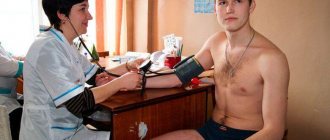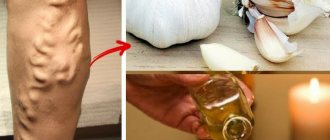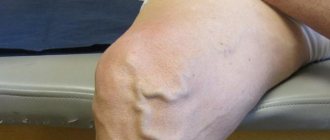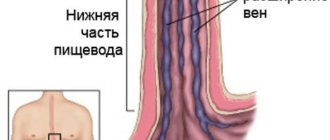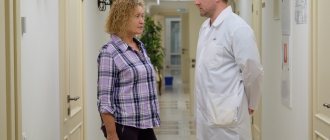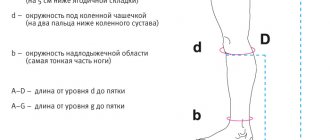- home
- Articles
- Schedule of illnesses
- Varicose veins and the army
»
»
»
Updated: October 24, 2021
Free hotline for conscripts and their parents
8
Along with many aging pathologies, varicose veins can also be mentioned. This is a rather serious disease that reduces the quality of life. In Russia alone, more than 38 million patients are officially registered. The pathology is “getting younger,” so the question of whether people with varicose veins will be accepted into the army in 2021 is very relevant for conscripts.
What kind of disease?
Varicose veins are a disease that manifests itself in the loss of elasticity of the walls of blood vessels, expansion of their lumen and deformation in the form of tortuosity and the formation of characteristic nodes. Varicose veins are also dangerous due to complications in the form of thrombosis, ulcers, and thrombophlebitis.
The main role in the occurrence of the disease belongs to heredity. But this is only a predisposition, and the trigger is lifestyle - mechanical stress on the veins during prolonged standing. Therefore, varicose veins are always associated with leg veins - the “Schedule of Diseases” does not even consider other options.
A special case is varicocele: varicose veins of the spermatic cord. Every fifth man suffers from it.
Causes of development of varicocele (varicose veins on the testicles)
The likelihood of varicoceles increases due to the following reasons:
- hereditary predisposition. Varicocele can be a consequence of congenital defects of the venous valves.
- reduction of venous lumen. A similar phenomenon occurs against the background of inflammatory diseases and injuries. A decrease in the lumen of the veins may be a consequence of a surgical operation, after which the process of scarring of the scrotal tissue is activated;
- the presence of chronic kidney disease is also the reason for the diagnosis of “Varicose veins”;
- increase in intra-abdominal pressure. With this pathology, the veins that surround the spermatic cord and testicle become overfilled with blood. An increase in intra-abdominal pressure is observed with frequent constipation, increased physical activity, and constant lifting of weights;
- leading an unhealthy lifestyle. If you abuse alcoholic beverages, include canned foods, cheap confectionery and fast food in your daily menu, the condition of blood vessels noticeably worsens and the risk of developing varicose veins increases.
Important! The risk of varicocele increases with exhausting sports and long-term use of steroid drugs, the use of which disrupts the hormonal balance in the body.
Stages of varicose veins
Classification of pathology:
- Stage I. The symptoms are the same, but spider veins also appear on the legs, pain is noted along the veins, and at night the calves of the legs cramp.
- Stage II. After walking or standing for a long time, the veins swell and can already be felt. There is a risk of blood clots forming.
- III degree. Added to the overall picture are swelling of the extremities, which do not go away by the morning.
- IV degree. The skin on the legs becomes shiny, cyanotic, thins and peels.
- V stage. Trophic ulcers appear, but they can still heal.
- VI stage. Ulcers do not heal.
Varicocele by stages
The first degree does not manifest itself, the dilation of the veins is not visible. Pathology can be diagnosed only by ultrasound of the scrotum. And given that ultrasound of the testicles is rarely performed, the early stage is most often not detected.
Second-degree varicocele already affects health, but only manifests itself during standing or physical activity. The pain is insignificant.
With varicocele of the third degree, varicose veins are visible to the naked eye. There is severe pain, the scrotum is dark purple in color.
Need help getting out of the army?
Call us at 8 (800) 550-25-66 or leave a request and we will answer any questions about the army and obtaining a military ID.
Request a call
How does the draft commission decide on the suitability of conscripts?
To be released from service, it is necessary to provide members of the draft commission with documentary evidence of the presence of varicose veins with the simultaneous development of venous insufficiency in the second degree.
Symptoms of this condition are:
- Feeling of pain in the lower extremities;
- Swelling of the legs that occurs after physical exertion and persists for a long time;
- Quick elimination of the listed symptoms after rest.
Other manifestations of varicose veins, which are not clearly expressed, are not accepted by the draft commission as a condition in which exemption from conscription should be granted. The degree of unfitness for military service is given to a conscript only if these two violations are confirmed. Upon receipt of a medical report, an entry is made in the military ID indicating the degree of suitability for certain types of military service or complete unsuitability.
Do they take you into the army with varicose veins?
The decision on the fitness for military service of conscripts and contract soldiers with varicose veins is made by the draft commission based on the presented objective medical data.
There is no separate article for varicose veins in the Schedule of Diseases. The disease is included in other vascular anomalies in Article No. 45, section nine (“Diseases of the circulatory system”) of the Decree of the Government of the Russian Federation No. 565 “On approval of the Regulations on military medical examination” dated July 4. 2013
Possible categories:
- “B” - I degree of varicose veins of the legs and II degree of the veins of the spermatic cord allows you to obtain fitness with restrictions (service in certain troops).
- “B” - the conscript will be sent to the reserve with grade II varicose veins with manifestations of venous insufficiency in the form of swelling after a long walk or long standing. This also includes grade III with any manifestations other than trophic ulcers. Also, conscripts are assigned this category for venous insufficiency of the spermatic cord without testicular atrophy (II degree) with repeated exacerbations or surgery.
- “D” - a conscript will receive a military ID for grade III or chronic venous insufficiency (CVI) with thinning, tension and hyperpigmentation of the skin, swelling, ulcers, scars. This form of the disease is called indurative-ulcerative in the Schedule. Varicose veins and the army are incompatible in this case.
Article 45 also mentions complications: thrombosis, phlebothrombosis, thrombophlebitis. In the first two cases, category “D” is assigned. In the case of thrombophlebitis, it must be “often recurrent.” However, the frequency is not specified.
People with grade III varicocele are also no longer accepted into the army. During the first call, a deferment for treatment will be given as standard. All this time, the disease will be monitored over time and, in case of a positive outcome, may be taken into the army for service.
Degrees of manifestation of varicose veins
In medical practice, two gradation systems are used, which roughly correlate with each other. The first, developed by domestic specialist V.S. Savelyev, is based on the body’s ability to cope with chronic venous insufficiency (to compensate for its manifestations). There are three stages:
- The first is the compensation stage. The body is able to almost completely cope with the symptoms, so there is no pronounced deficiency yet. Characteristic sensations of heaviness, incomprehensible discomfort, bloating, and short-term swelling. They are often ignored and delays in going to the doctor. Approximately corresponds to the first two stages of the international gradation.
- The second is the stage of subcompensation. The body, as they say, copes with its last strength, and only partially. Venous insufficiency is pronounced. Characterized by prolonged or even constant swelling, pain in the legs, night cramps of the calf muscles, prominent veins, and skin pigmentation. Most often, a doctor is consulted at this stage. Approximately corresponds to the third to fifth stages of the international gradation system.
- The third is the stage of decompensation. The body is no longer able to cope with the symptoms, among which there are new ones - deep trophic changes: pigmentation, thickening of the subcutaneous tissue, ulcers. Venous insufficiency is obvious, with twisted, nodular dark veins visible under the skin. Approximately corresponds to the last three stages of the international gradation.
Complications in the form of thrombosis, thrombophlebitis, eczema are possible at any stage, but most often occur at the stage of sub- and decompensation. In addition to this system, for clinical purposes they use the international gradation of the World Health Organization of seven (sometimes six and five) levels, differing in the external manifestation of varicose veins:
- Spider veins. Point manifestations in the form of compacted, enlarged nodes visible under the skin. Observed at the compensation stage.
- Reticulum veins. Focal manifestations in the form of a reticulum are a network of dilated veins in a small area of skin. They develop at the compensation stage.
- Dilated veins. The classic version – curved, swollen dark vessels are visible over a considerable distance. A sign of the subcompensation stage.
- Swelling of the limb. Short-term swelling is replaced by permanent swelling. There is not enough rest time that she slept. This is the subcompensation stage.
- Trophic changes. In a narrow sense, this refers to skin pigmentation and thickening (induration) of subcutaneous tissue. Stage of sub- or decompensation.
- Healing skin ulcers. These are deeper trophic changes characteristic of the decompensation stage. The speed of healing can vary greatly.
- Non-healing skin ulcers. The last stage, the most profound trophic changes, develop with complete decompensation. Constantly open ulcers.
Sometimes ulcers are combined into one stage, regardless of whether they heal or not. In some cases, they are accompanied by the stage of initial trophic changes.
The stages of varicose veins are indicated in the formulation of the diagnosis. But for the purposes of military medical examination they are secondary. Of immediate importance are the severity of pathological manifestations, to which the stages of varicose veins are already attached.
Comparison of international and domestic grading systems for varicose veins of the lower extremities.
How to get exemption from service for varicose veins in 2021?
All legal grounds for exemption from service in the Armed Forces are specified only in the law on military service. No other document contains any grounds.
All that is required of a conscript in 2021 to obtain exemption from military service is to correctly collect the necessary medical documents. If they are properly completed, with confirmation of a degree that does not involve service, the conscript may be issued a military ID or sent to the reserves.
You should definitely contact a hospital or private clinic (if it has a state license). You will need to undergo an angiocontrast study (radionuclide, x-ray), Doppler ultrasound data (vein scanning).
You will need to be treated in the hospital several times. This will serve as additional confirmation of the diagnosis for VVC. The outpatient card must indicate all cases of exacerbations (more than 2), visits and hospitalizations, as well as prescribed therapy.
As a result, you need to bring to the commission:
- outpatient card with all recording facts;
- extracts from medical records;
- examination results confirming the diagnosis and the degree of varicose veins.
If during a medical examination doctors ignore complaints and award a higher category with fitness for service, the conscript can appeal the decision of the Military Military Commission and appeal to the commissar of the military registration and enlistment office or to court (Federal Law “On Military Duty and Military Service”, paragraph 7, article 28). A military lawyer can represent the interests of the plaintiff. From the moment you go to court, the conscription is suspended.
Summon Features
There are several health groups that determine where a potential conscript will be sent:
- Group A - a young man is suitable for military service and can serve in any type of army.
- Group B - the young man is fit for military service, but there are a number of restrictions regarding the place of service and the type of troops.
- Group B - the person is a reserve warrior. This suggests that as long as there is peace in the country, the conscript is not required to serve in a military unit. But if martial law is suddenly declared, he will be sent a summons to the military registration and enlistment office.
- Group D – provision of deferment. The conscript is given a certain time period during which he must recover and receive group A or B. The period is about six months.
- Group D – the famous “white ticket”. It says that a person is completely exempt from military service.
Procedure for passing a medical examination
If a young man has varicose veins of the extremities, he should do the following:
- Having received a summons, you need to contact a phlebologist to make a diagnosis;
- you need to undergo a vascular ultrasound and assess the severity of the disease;
- all medical certificates from the medical commission must be submitted, including a doctor’s report;
- after a visual examination of the conscript and familiarization with the documents, the doctor has the right to refer the young man for additional examinations;
- If the diagnostic result confirms the presence of pathology, the guy will receive a deferment.
It is important to understand that surgeons working in the military registration and enlistment office will not seriously consider the pathological process. Therefore, it is recommended to contact a specialized medical center to get a competent doctor’s consultation and undergo a comprehensive examination of the body.
To summarize, it is worth saying that each specific case is considered individually. In any case, everything depends on the severity of the disease and the decision of the draft commission. Usually, a young man is not accepted into the army if he has 2 or 3 degree varicose veins.
Postthrombophlebitic disease: treatment methods
Treatment of such a disorder is a complex and lengthy process in which a wide variety of treatment methods are used. Conservative methods are aimed at combating the symptoms of venous insufficiency. For this purpose, patients are prescribed modern drugs that increase the tone of the venous wall, improve microcirculation and lymphatic drainage function, and protect the vessel from damage. To relieve swelling, it is also recommended to wear good compression tights or stockings. Sessions of lymphatic drainage massage and variable hardware pneumatic compression will be useful. But this is only possible if trophic disturbances are not yet too pronounced. With the progression of trophic disorders, modern surgical treatment is indicated. The most effective and best method for today is the technique of minimally invasive intravascular stenting of veins. This innovative European intervention in Moscow is carried out under ultrasound and x-ray control.
Accurate diagnosis is the basis for a conclusion about suitability
Let's leave aside the conscript's personal reluctance not to join the army. And let's look at the problem from a different point of view, namely, let's try to predict the situation for future life.
To accurately determine the degree of circulatory disorders with varicose veins, only a consultation with a surgeon who is seen at the military registration and enlistment office will not be enough. A young man definitely needs to see a phlebologist - a specialist closely involved in the diagnosis and treatment of varicose veins.
Modern medical equipment, such as an ultrasonograph, allows the doctor to make the most accurate conclusions. True, such devices are only available in specialized clinics, but if necessary, they are not difficult to find.
When choosing, you need to focus on the Baltic Vein Clinic, a medical institution specializing in the treatment of varicose veins. Using advanced diagnostic techniques, board-certified phlebologists will thoroughly understand your case of varicose veins. And they will determine the further strategy of behavior.
Over the years, varicose veins can cause serious complications and can even deprive you of mobility. Therefore, you need to part with him without regret already in your youth. It is better to cure varicose veins and serve with dignity in the Armed Forces than to be considered a chronically ill person at the age of 18–20.
After treatment for varicose veins, the guy, of course, will not be sent to the Honor Guard Company, but it is quite possible to serve in the radio engineering troops.
When is a deferment due?
In some cases, the medical board doctors prescribe a re-examination after a 6 or 12 month delay. This option will allow you to track the dynamics of varicose veins and determine the young man’s suitability for service.
A deferment from conscription is given if there is a referral for surgery. In this case, its duration will depend on the recovery period. It cannot exceed 1 year.
The type of surgery depends on the course of the disease and the likelihood of complications. If the situation eventually improves, the young man will have to join the army.
Important! The commission's actions can be appealed administratively and judicially. While the case is being investigated, the guy cannot be taken into service.
Suitability categories
There are categories of suitability for military service, thanks to which it is determined whether a young man can enter the service of the Armed Forces of the Russian Federation. There is a certain classification, which we will now consider.
Category A
Considered fully fit for military service. At the same time, the young man has no contraindications, no health problems.
Young people who have this group have the right, after military service, to serve under a contract, as well as in specialized troops. This category predisposes to serve in elite troops. The group has its own divisions:
- A1 – valid without restrictions.
- A2 – valid with restrictions. Restrictions may occur after an injury or fracture. But this group does not exclude serving in special forces.
- A3 – suitable with restrictions. Limitations, such as vision problems.
- A4 – valid with restrictions. Limitations are associated with bone problems, such as flat feet.
Category B
This category says that the young man is fit to perform military service with minor restrictions. This category includes young people who have diagnoses such as scoliosis, grade 2 flat feet, and chest deformity. At the same time, the choice of troops in which I would like to serve is decreasing. So, depending on the group B1, B2, B3 and B4, it is determined in which troops the young man can serve. For example:
- B1 - marines, airborne troops, air assault troops, border troops, often for military intelligence.
- B2 - submarines, self-propelled artillery units.
- B3 - drivers and crew members of combat vehicles, units of internal troops of the Ministry of Internal Affairs, guard units, anti-aircraft missile units, chemical military units.
- B4 - parts of military installations, security and defense specialists for combat missile systems, communications units, radio engineering units, technical cargo units.
Category B
The group says the young man has limited fitness for military service. Group B exempts guys from conscription in peacetime. Young people with this group are placed in the reserves, but during military training they are subject to mandatory enrollment. This group also reserves the right of a young man to re-examine his health group for service in peacetime.
Category G
The group speaks of the young man's temporary unfitness. In this case, the young man is given a temporary deferment from military service. The delay may not be related to the young person’s health. This could be studying at a university.
Category D
This category indicates that the young man is unfit for military service. A complete exemption from military service is given, both in peacetime and not. In this case, a military ID is issued, which states complete unfitness for service.
Partner advertising
Causes of postthrombophlebitic disease
Deep vein thrombosis involves the formation of a clot (thrombus) that blocks the lumen of the vein and impedes the outflow of blood. Subsequently, the thrombus either resolves or is replaced by connective tissue. In the first case, the lumen of the vessel is restored, in the second it disappears. Whatever the outcome of thrombosis, the vascular valves are damaged, which leads to disruption of blood flow in the deep veins. Since the deep veins can no longer function normally, blood is released into superficial vessels, which are not equipped to move such amounts of fluid. As a result, the superficial veins dilate, causing secondary varicose veins. As the disease progresses, all venous vessels of the lower extremities are affected. Deep vein thrombosis does not always lead to the development of such a disorder. If you consult a good doctor in time, the development of postthrombophlebitis syndrome can be avoided. Timely diagnosis and competent modern treatment can minimize the consequences of deep vein thrombosis.
